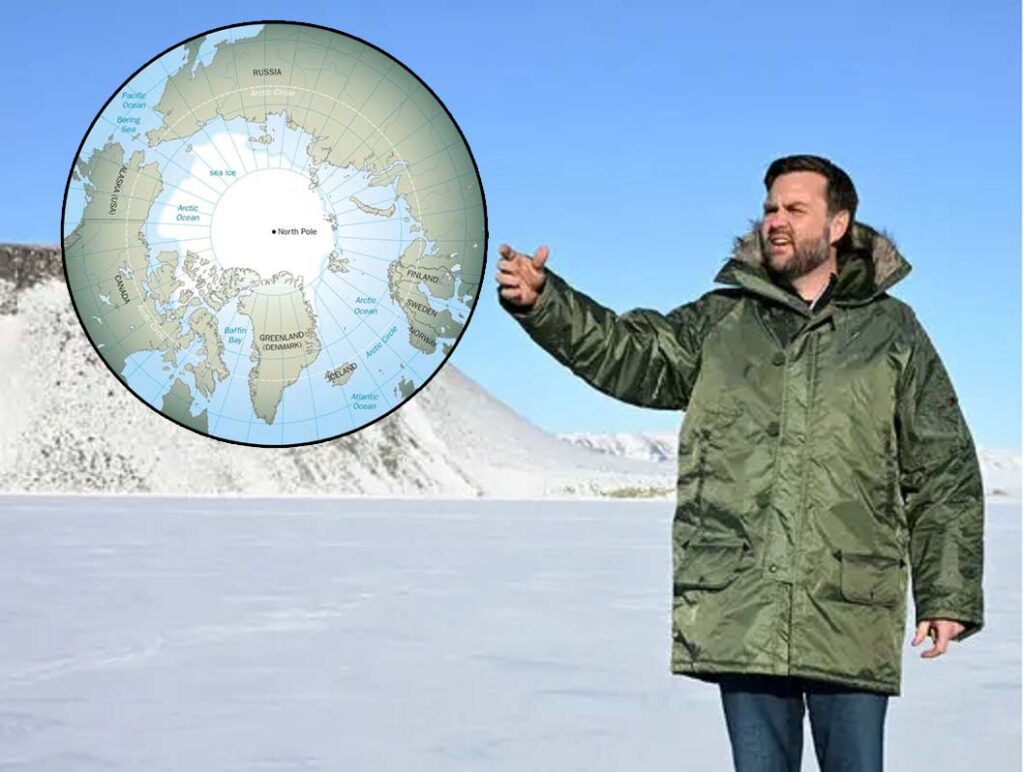
- The controversial visit by U.S. Vice-President JD Vance and Second Lady Usha Vance, which was first presented as a cultural trip but has now been reframed as a national security mission
- The visit is representative of changing global security dynamics that affect everything from Europe to Asia.
- India sees both chances and dangers as the United States steps up its military and strategic presence in Greenland as part of a larger campaign to thwart China’s growing influence and its planned “Polar Silk Road.”
- The United States’ attempt to secure Greenland, however, is part of a larger geopolitical realignment that affects the whole international system.
With a population of just over 56,000, Greenland has long been a peaceful region of the Arctic. Recent events, however, have thrust this frigid region into the international scene, serving as both a focal point of American strategic aspirations and a pivotal site in the larger struggle for Arctic dominance. The controversial visit by U.S. Vice-President JD Vance and Second Lady Usha Vance, which was first presented as a cultural trip but has now been reframed as a national security mission, is representative of changing global security dynamics that affect everything from Europe to Asia.
From Cultural Diplomacy to Strategic Posturing
Second Lady Usha Vance’s original plan was for a pleasant cultural trip that would allow her to learn about Greenland’s rich past, see its famous dogsled race, and engage with the local population. Vice-President Vance’s sudden decision to accompany the trip, however, changed its purpose from cultural exchange to a show of American determination to secure the Arctic. “To re-energize the security of the people of Greenland, we’re going to check out how things are going there,” he said (Associated Press, 2025a). President Trump’s long-standing claims that the US is prepared to “buy” or even militarily protect Greenland if necessary are echoed in this remark. These claims have caused unease among Danish and Greenlandic officials.
Greenland at the Crossroads of Arctic Geopolitics
A people that is passionately involved in the issue of sovereignty is shown by the recent parliamentary elections in Greenland, where the center-right Demokraatit Party soared to over 30% of the vote, a significant increase from only 9% four years previously. Improvements in healthcare, education, and economic reform are given top priority in the party’s program, which calls for a slow and deliberate approach to complete independence from Denmark. Independence is desired by Greenlanders, but it must be based on a sound economic basis, particularly given how heavily the island’s economy now rests on Danish subsidies (El País, 2025).
Beyond these internal arguments, however, Greenland’s geopolitical significance cannot be denied. The island is crucial to the developing geopolitical struggle because of its enormous rare-earth material resources and strategic position between the North Atlantic and the Arctic. In addition to pitting the US against Denmark, this competition also involves the aspirations of major international entities like China, Russia, and even India.
Arctic Geopolitics and India’s Emerging Role
India, which has been gradually forming its Arctic strategy and has observer status in the Arctic Council, is becoming more aware of the changing balance of power in the area. India sees both chances and dangers as the United States steps up its military and strategic presence in Greenland as part of a larger campaign to thwart China’s growing influence and its planned “Polar Silk Road.” Indirectly affecting countries like India that are eager to preserve the balance of power in the Arctic, the U.S. action in Greenland is part of a larger geopolitical shift where smaller territories are used to establish dominance over vital areas.
Besides safeguarding its strategic interests in a region where it competes for influence with China and Russia, India’s Arctic engagement is motivated by a twofold imperative: to establish new trading routes and ensure access to critical resources (Ministry of External Affairs, 2022). Thus, the U.S. focus on Greenland must be viewed as a player in a larger, complex game of geopolitical chess also involving the thwarting of China’s economic and infrastructure plans in the Arctic.
A Broader U.S. Strategy: Implications for Global Security
The United States’ focus on Greenland seems to be a component of a larger plan to establish control over smaller, well-positioned regions throughout the globe. The United States indicates its intention to defend and extend its area of influence by aggressively interacting with Greenland, a move backed by a 1951 military deal with Denmark. But this strategy poses significant issues for other countries, especially those that could be at risk from big-power influence. These days, smaller nations and areas have to deal with a situation where their strategic significance might work against them by drawing both financial investments and geopolitical pressures.
An overly assertive U.S. posture, according to policy analysts, may alienate not only Greenland but also other partners in Europe and beyond. According to one expert, “turning your back on your allies is the best way to undermine America’s long-term influence” (The Guardian, 2025). Global security will be impacted by this fine line between defending national sovereignty and advancing strategic interests, which will affect how nations in Asia, Europe, and other regions develop their foreign policy.
The Road Ahead: Self-Determination Amid Global Ambitions
The road to total independence is still a long and difficult one for Greenland. Although independence is widely supported, most Greenlanders want a cautious, gradual approach, one that fortifies local institutions and social services before cutting connections with Denmark, according to the results of the most recent elections. This methodical approach stands in stark contrast to the swift, unilateral policy that some American expansionists support.
The United States’ attempt to secure Greenland, however, is part of a larger geopolitical realignment that affects the whole international system. The circumstances highlight the need for India to have an active Arctic strategy that can protect its interests and support a stable regional power structure. India’s position as an observer and developing player is becoming more important as the U.S. and China step up their Arctic manoeuvres to make sure the area stays a place of collaboration rather than war.
In conclusion, changing global power dynamics provide a background for Greenland’s quest for self-determination. The United States’ campaign in Greenland is representative of a larger strategy that has significant ramifications for both global security and the geopolitical interests of countries like India. It goes beyond just safeguarding a remote region. The world attentively monitors Greenlanders’ assertion of their right to self-determination, keeping in mind that the Arctic’s future might significantly influence the distribution of power for many years to come.
References:
- Associated Press. (2025a, March 25). US Vice President JD Vance is to join his wife in Greenland on Friday. AP News. https://apnews.com/article/e5d53819bfeb622c9e56d5fc2bcdb889
- El País. (2025, March 12). El independentismo moderado gana las elecciones en Groenlandia. El País. https://elpais.com/internacional/2025-03-12/el-independentismo-moderado-gana-las-elecciones-en-groenlandia.html
- Ministry of External Affairs, Government of India. (2022). India’s Arctic Policy. Ministry of External Affairs. https://mea.gov.in/ArcticPolicy
- The Guardian. (2025). Greenland’s likely new prime minister rejects Trump takeover efforts. The Guardian. https://www.theguardian.com/world/2025/mar/13/greenland-new-prime-minister-jens-frederik-nielsen
Shashank is a Master’s student in Diplomacy, Law, and Business at O.P. Jindal Global University. He is also a researcher and coordinator at the Center for Global South and the Center for Southeast Asian Studies. His research interests include Southeast Asia, Chinese foreign policy, India’s Act East Policy, and global security dynamics. Views expressed are the author’s own.
